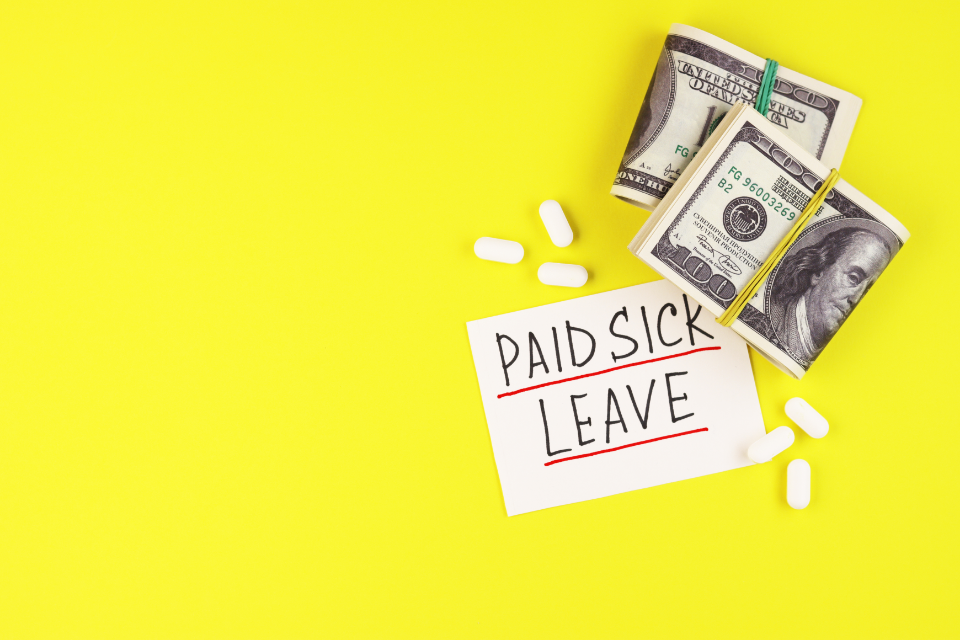According to the US Bureau of Labor Statistics, in March 2021, 79 percent of civilian workers had access to paid sick leave. It is surprising because no federal laws mandate businesses to offer paid sick leave to their workers. However, there are some state and county-level paid sick leave laws.
Paid sick leave is an essential employee perk that most employers provide in one form or another. For example, some employers offer a lump-sum leave package, while others combine sick leave and PTO. Whatever the method, sick leave is a crucial component of high productivity.
Healthy employees are more productive. If you do not provide sick leaves, many employees will prefer to work instead of remaining home to prevent wage loss. So, they'll show up at work unwell and try to work, but they'll be less productive.
The Golden State takes paid sick leaves very seriously.
California is one of the first states in the USA to mandate that employers give paid sick leave to their employees. In addition, the Healthy Workplace, Healthy Family Act of 2014, or the HWHF Act, applies to all companies, regardless of size.
With that said, let's understand the ins and outs of California's paid sick leave law.
Table of Content:
- What Is California's Paid Sick Leave Law, and What Are the Essential Requirements for Employees?
- Sick Leave Law: Everything That Employers Must Know
- How many Paid Sick Leave should you provide for Your Employees?
- How to Comply with Paid Sick Leave Laws?
- Step 1: Provide Employees With Necessary Information
- Step 2: Determine the Conditions or Restrictions on Paid Sick Leave
- Step 3: Determine the Pay Rate
- Step 4: Give Employees Advance Notice
- Step 5: Keep Detailed Records
- Bottom Line
- How Can Deskera Help You?
- Frequently Asked Questions
- Key Takeaways
Let's Start!
What Is California's Paid Sick Leave Law, and What Are the Essential Requirements for Employees?
According to the state's paid sick leave law, every worker who operates in California for 30 days or more in a year after commencing work is eligible for paid sick leave.
As per the HWHF Act, workers, including part-time and contractual staff, are eligible for at least one hour of paid leave every 30 hours. The paid sick leave act applies to all companies with workers in California, with a few caveats.
In addition to the state legislation, California has various local sick-leave policies which often diverge from the state standards. For instance, Los Angeles and Long Beach paid leave rules to apply only to the hospitality industry.
The following are the essential requirements for employees covered by California's paid sick leave law:
· Employees who don't need to work overtime earn paid sick leave on a 40-hour workweek basis.
· From their 90th day of work, new employees can use paid sick leave.
· Employers can impose acceptable minimum increments (up to two hours) for employees to use paid sick leave.
· Employers can restrict paid sick leaves to 48 hours or six days.
· Employees who take paid sick leave are not subject to retaliation. Employers can not penalize employees for taking paid sick leave.
Next, let's look at what employers should know regarding paid sick leave laws.
Sick Leave Law: Everything That Employers Must Know
A checklist of what companies must do to comply with new and existing sick leave regulations follows:
· Each calendar year, provide at least three days of paid sick leave to all qualified employees.
· Document sick leave rules and make them available to new hires.
· Regularly track, and report each employee's paid sick leave balance.
· Maintain a three-year record of earned and spent vacation days.
But, how much paid leave should you give to your employees? There are several ways of calculating it.
How many Paid Sick Leave should you provide for Your Employees?
Employers can provide paid sick leave to their workers in one of the three ways:
1. Statutory Accrual Method: Employees are eligible for a minimum of one hour of paid sick leave for working 30 hours, starting from the first day.
For example, a 60-hour-per-week employee would collect 2 hours of paid sick leave every week.
2. Lump-sum Method: Businesses can offer a lump sum of a minimum of 24 hours or three days of paid sick leave at the start of each 12-month term. Within 120 days of their start date, employers must give recruits a lump amount of paid sick leave. When determining the 12 months, employers might use the employee's joining date, the calendar year, or other timeframes.
3. An existing paid-time-off (PTO) policy: Existing paid leave arrangements are valid as long as they comply with the Healthy Workplaces, Healthy Families Act of 2014.
Current sick-leave arrangements in force before January 1, 2015, can meet the requirements of the state laws if they include the following provisions:
· Workers must have one day or eight hours of paid sick leave within the first three months.
· Workers must have at least three days of sick leave after nine months.
Any modifications to a grandfathered policy will cause the policy's grandfathered status to be null and void, and the employer will have to follow the law's provisions.
Now, let's see how you can comply with the paid sick leave laws.
How to Comply with Paid Sick Leave Laws?
Once you have figured out how much paid sick leave you will provide your employees, next is implementing them according to the law.
And, here's how you can do it.
Step 1: Provide Employees With Necessary Information
Employers must display the DoLS Enforcement poster containing information about paid sick leave on their premises. However, employers with employees in California who operate from remote locations, home offices, or client offices can send the poster to those employees besides posting it in the workplace.
Step 2: Determine the Conditions or Restrictions on Paid Sick Leave
HWHF Act of 2014 empowers employers to determine the conditions or restrictions on paid sick leave. Here are some limits that employers can put in place:
· Waiting time: While the law mandates that sick leave accrue immediately upon employment, employers may opt to impose a 90-day waiting period before recruits may use their accrued paid sick leave.
· Accumulation cap: Employers can also opt to limit accruals to 48 hours or six days, whichever is greater.
· Minimum increments: Employers can compel employees to take paid sick leave in two-hour increments at a minimum. However, employers can also allow smaller increments.
· Reasons for leave: Businesses must enable staff to take paid sick leave for themselves or a close relative in the given situations:
· Diagnostic or preventive care
· Treatment or care for an established medical problem
· For special purposes, for survivors of domestic violence, sexual harassment, or intimidation
It is important to note that employers can not interfere with an employee's freedom to use paid sick leave. Even if an employee does not offer specific information regarding the need for sick leave, the employer must allow it.
Under the paid sick leave law, family members include parent, child, spouse, grandparent, grandchild, or sibling.
Next is determining the pay rate during the leave period.
Step 3: Determine the Pay Rate
Under paid-sick-leave laws, employers must pay non-exempt employees as they were working during their leave period.
Similarly, exempt employees should receive paid sick leave in the same manner as other types of paid leave.
Step 4: Give Employees Advance Notice
During hiring, employers must provide written notice of paid sick leave to all non-exempt workers under the HWHFA.
For compliance with this notification requirement, the state has updated the California Wage Theft Protection Act to include information about paid sick leave.
Employers must additionally show available paid sick leave balances on the employee's pay stub or a separate document sent with the payment.
They must communicate and explain to employees the paid-leave policy, which outlines the availability of paid sick leave and any restrictions the employer may impose on its usage, as authorized by law.
Step 5: Keep Detailed Records
Employers must preserve records for at least three years of paid sick leave offered to employees and the amount of paid sick leave each employee uses. Employers should keep track of paid sick leave time separately from other forms of leaves to guarantee compliance.
And that's it!
If you follow these five steps, complying with paid sick leave law will be a no-brainer!
Bottom Line
Paid sick day leaves are necessary for the worker and businesses. Allowing employees to take one day off and losing the work from that one day will help your business more, instead of more days of lower-quality work. The person may rest, recover, and return to work rejuvenated and more productive.
However, managing, tracking, and keeping records of employees' paid sick day leave can be a challenging and time-consuming task. This is where automation tools like Deskera come in handy.
How Can Deskera Help You?
Deskera People simplify handling leave, attendance, payroll, and other costs. In addition, it makes payslip generation easier since the platform also digitizes and automates HR activities.
But wait, there is more!
The employee grid in Deskera People displays all the employee's crucial information at a glance. With filtering options available in every column of the array, it is easy to find the data you are looking for.
And that is everything you must know about California's HWHF Act and paid sick leave law.
Frequently Asked Questions
Ques-1: When Is an Employee Eligible for Paid Sick Time?
An eligible employee accrued paid leave from 1/July/2015 or from the day they start working if recruited after that date. A worker becomes eligible after 90 days of hire.
Ques-2: Is It Possible for All California Employees to Apply for Paid Sick Leave Under the New Law?
With some caveats, this rule covers all workers working in California for at least 30 days for a company, including part-time, temporary, and per-hour employees. However, the following employees are ineligible for paid sick leave under this law:
· Employees who are covered by specific union agreements
· Employees who have retired from the government
· Individuals working as cabin crew or on the flight deck for an airline if they receive compensated time off at least equal to the new law
Ques-3: What Is a Calendar Year?
You can use the employee's joining date to track the calendar year's measurement.
How Deskera Can Assist You?
As a business, you must be diligent with the employee payroll system. Deskera People allows you to conveniently manage payroll, leave, attendance, and other expenses. Generating payslips for your employees is now easy as the platform also digitizes and automates HR processes.
Key Takeaways
· California is one of the first states in the USA to mandate that employers give paid sick leave to their employees.
· The Healthy Workplace, the HWHF Act, or Healthy Family Act of 2014, applies to all companies, regardless of size.
· According to the state's paid sick leave law, every worker who operates in California for 30 days or more in a year after commencing work is eligible for paid sick leave.
· It includes part-time and contractual staff also.
· You must provide at least three days of paid sick leave to all qualified employees for each calendar year.
· Businesses have three options for providing paid sick leave to their workers:
· Statutory Accrual Method
· Lump-sum Method
· Paid-time-off (PTO) policy
· Once you have figured out how much paid sick leave you will provide your employees, next is implementing them according to the law. Follow these steps to implement it properly:
· Step-1: Provide Employees With Necessary Information
· Step-2: Determine the Conditions or Restrictions on Paid Sick Leave
· Step-3: Determine the Pay Rate
· Step-4: Give Employees Advance Notice
· Step-5: Keep Detailed Records
· Paid sick day leaves are necessary for workers and businesses as healthy employees are more productive.
Related Articles











